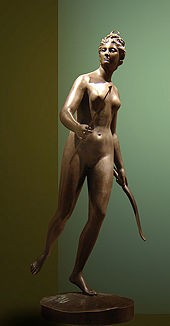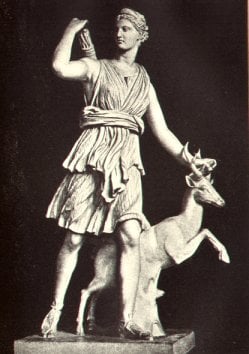Diana (mythology)
In Roman mythology, Diana was the goddess of the hunt, in literature the equivalent of the Greek goddess Artemis, though her cult was Italic in origin. The daughter of Zeus and Latona, Diana was born with her twin brother Apollo on the island of Delos.
Hunting goddess
Diana was the hunting goddess, associated with wild animals and woodlands. She also later became a moon goddess, supplanting Luna, and was an emblem of chastity. Oak groves were especially sacred to her. She was praised in poetry for her strength, athletic grace, distinct beauty and hunting skill. In practice she made up a trinity with two other Roman deities: Egeria the water nymph, her servant and assistant midwife; and Virbius, the woodland god. In her etymology, "Diana" is simply :"the Goddess," with a Greek parallel in the name—though not the cult practice—of Dione at Dodona. She was goddess of fertility and quick to anger.
Diana was worshiped at a festival on August 13,[1] when King Servius Tullius, himself born a slave, dedicated her shrine on the Aventine Hill in the mid-sixth century B.C.E. Being placed on the Aventine, and thus outside the pomerium, meant that Diana's cult essentially remained a 'foreign' one, like that of Bacchus; she was never officially 'transferred' to Rome as Juno was after the sack of Veii. It seems that her cult originated in Aricia,[2] where her priest, the Rex Nemorensis remained. There the simple open-air fane was held in common by the Latin tribes,[3] which Rome aspired to weld into a league and direct. Diana of the wood was soon thoroughly Hellenized,[4] "a process which culminated with the appearance of Diana beside Apollo in the first lectisternium at Rome".[5] Diana was regarded with great reverence by lower-class citizens and slaves; slaves could receive asylum in her temples.

Though some Roman patrons ordered marble replicas of the specifically Anatolian "Diana" of Ephesus, where the Temple of Artemis stood, Diana was usually depicted for educated Romans in her Greek guise. If she is accompanied by a deer, as in the Diana of Versailles (illustration, above right) this is because Diana was the patroness of hunting. The deer may also offer a covert reference to the myth of Acteon (or Actaeon), who saw her bathing naked. Diana transformed Acteon into a stag and set his own hunting dogs to kill him.
Diana worship is mentioned in the book of Acts in the Bible (Chapter 19, verses 21-41).
Notes
- ↑ The date coincides with the founding dates celebrated ar Aricium. Arthur E. Gordon, "On the Origin of Diana," Transactions and Proceedings of the American Philological Association 63 (1932, pp. 177-192) p 178.
- ↑ Her cult at Aricia was first attested in Latin literature by Cato the Elder, in a surviving quote by the late grammarian Priscian. Supposed Greek origins for the Aricia cult are strictly a literary topos. (Gordon 1932:178 note, and p. 181).
- ↑ commune Latinorum Dianae temple in Varro, Lingua Latina v.43; the cult there was of antique religione in Pliny's Natural History, xliv. 91, 242.
- ↑ The Potnia Theron aspect of Hellenic Artemis is represented in Capua and Signia, Greek cities of Magna Graecia, in the fifth century B.C.E.
- ↑ Gordon 1932:179.
See also
- Diana Nemorensis
- Wild Hunt
External links
| |||||
Credits
New World Encyclopedia writers and editors rewrote and completed the Wikipedia article in accordance with New World Encyclopedia standards. This article abides by terms of the Creative Commons CC-by-sa 3.0 License (CC-by-sa), which may be used and disseminated with proper attribution. Credit is due under the terms of this license that can reference both the New World Encyclopedia contributors and the selfless volunteer contributors of the Wikimedia Foundation. To cite this article click here for a list of acceptable citing formats.The history of earlier contributions by wikipedians is accessible to researchers here:
The history of this article since it was imported to New World Encyclopedia:
Note: Some restrictions may apply to use of individual images which are separately licensed.
